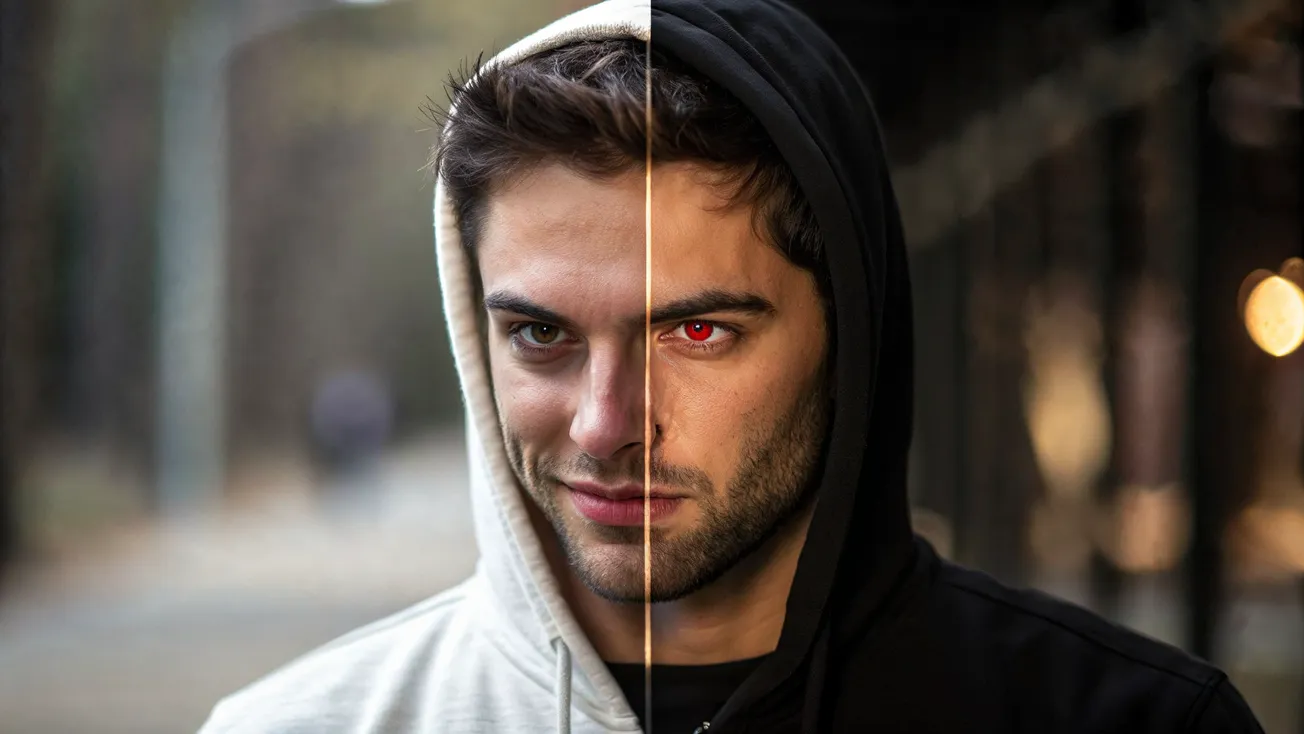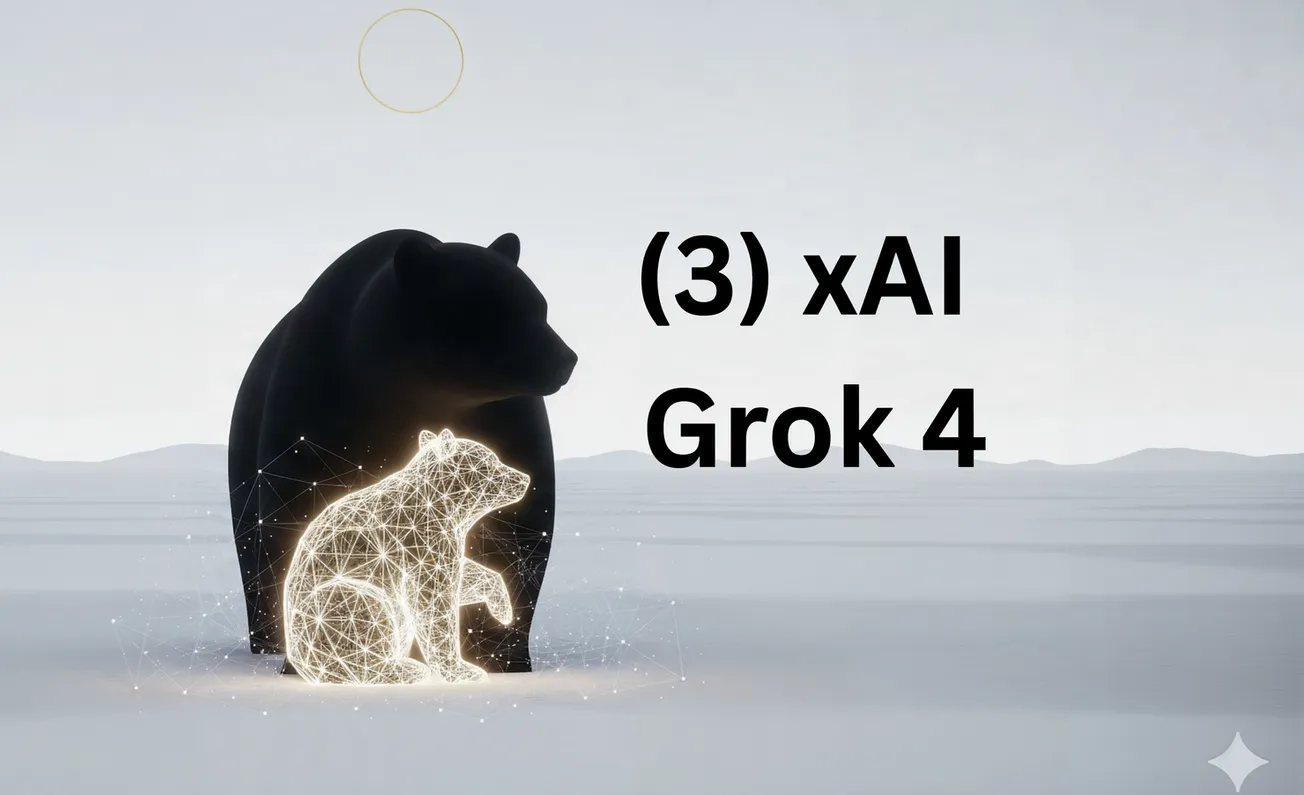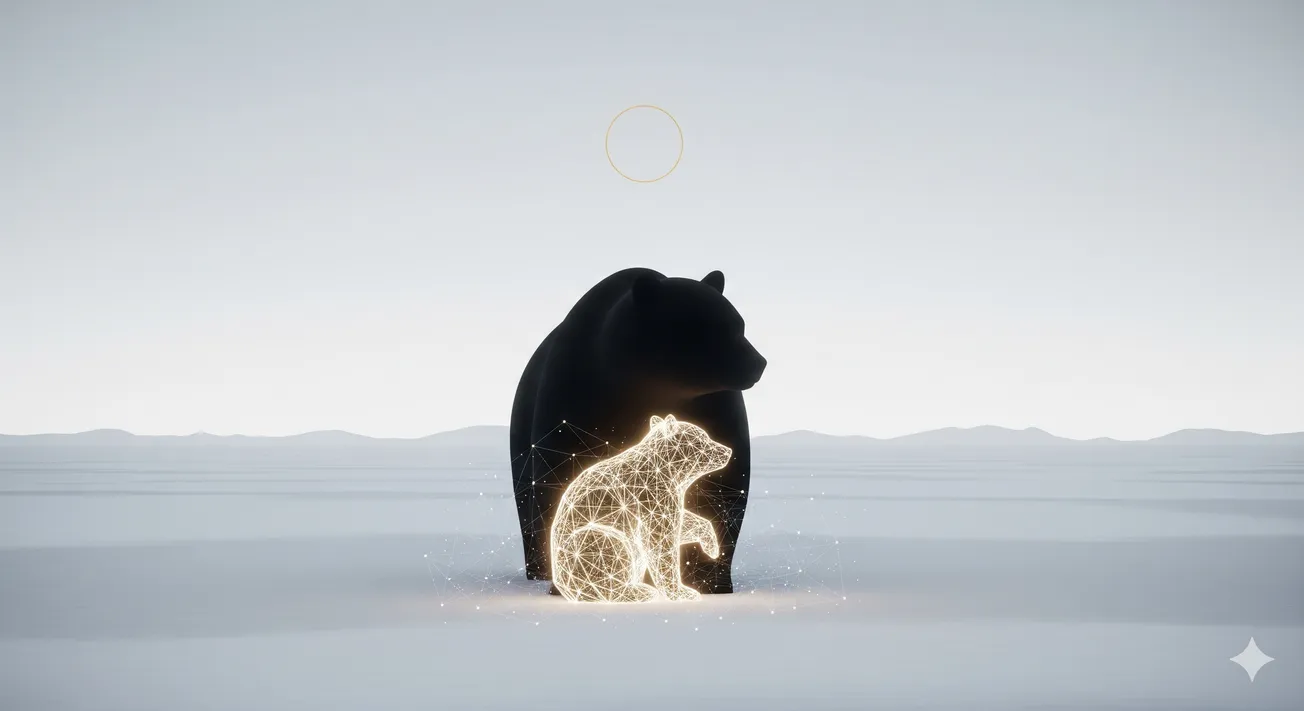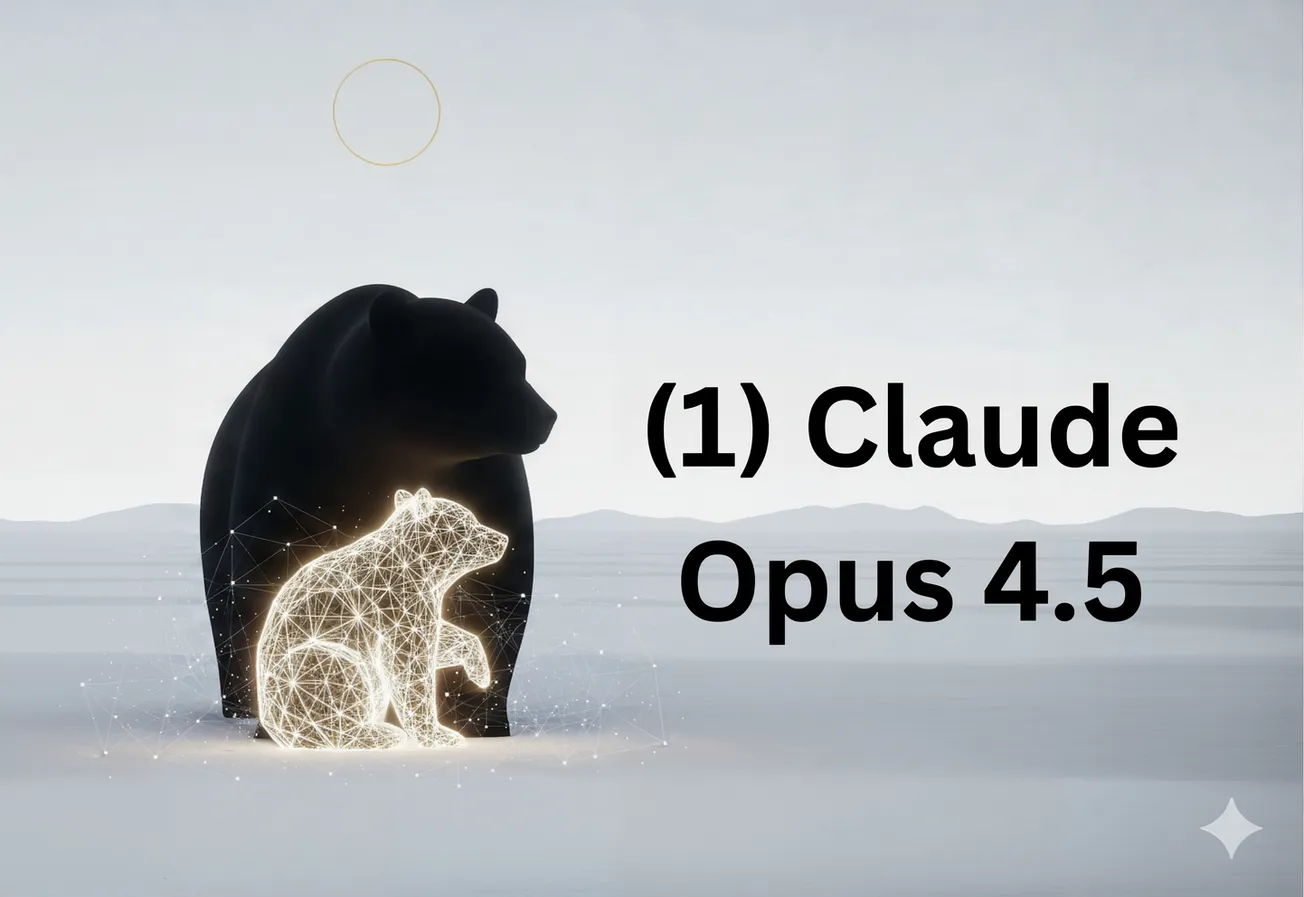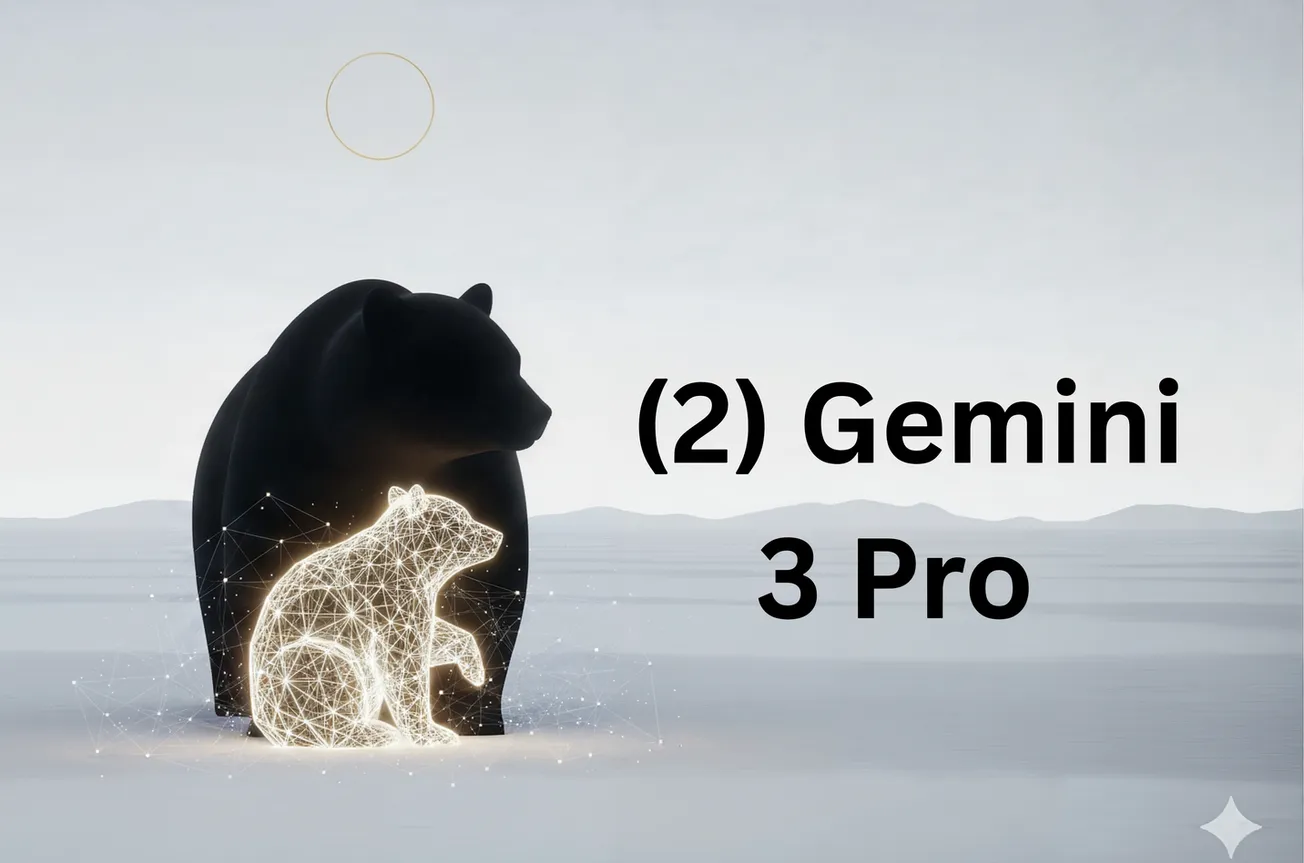Table of Contents
Introduction
What is the source of our sense of right and wrong—our moral compass? This profound question spans myth, philosophy, science, and technology. From ancient scripture to modern AI, thinkers have sought the ontological roots of “good” and “evil” and how we come to know moral truths. This thesis explores these depths in an interdisciplinary journey. We begin with the biblical story of Adam and Eve as an allegory of moral awakening: the moment humanity first “knew” good and evil by eating from the forbidden tree, and the ensuing shame at their nakedness. This archetypal fall from innocence introduces the idea that evil might emerge as a mental instantiation—a concept recognized by a conscious mind capable of judgment. Building on this foundation, we delve into classical philosophy, examining how Plato’s notion of the Good (and later the Godhead in Neoplatonism) frames the reality of moral values and the nature of evil. We then bridge into modern thought: the debate between moral realism and anti-realism (do objective moral facts exist?), alongside insights from evolution and neuroscience into how moral cognition arose in our species. Finally, we turn to the era of artificial intelligence and cognitive science, asking how intelligent agents—human or machine—can recognize and act upon moral principles. Is there an analog of the moral compass in AI, perhaps a “reward function” that encodes an objective ethical truth? Could such a function be discoverable, in a Platonic sense, as the mathematical encapsulation of the Good? We explore whether this hypothetical “true” reward function might bridge truth, love, and conscious alignment for both AGI and humanity. In conclusion, we consider a possible future moral singularity in which aligned moral knowledge could allow light to prevail over darkness—a world where the good triumphs over evil. Throughout, we maintain academic rigor and an exploratory tone, drawing on philosophy, theology, science, and AI ethics literature to illuminate known and unknown dimensions of our moral compass.

The Fall and the Rise of Moral Awareness: Adam, Eve, and the Knowledge of Good and Evil
Human moral consciousness is often portrayed as something gained—and lost—in a primordial moment. In the Book of Genesis, Adam and Eve dwell in innocence until they partake of the Tree of Knowledge of Good and Evil. According to the narrative, “the eyes of both of them were opened, and they knew that they were naked” (Genesis 3:7). The sudden awareness of their nakedness symbolizes a newfound moral knowledge and the birth of conscience. Before eating the forbidden fruit, the first humans are described as naked and “not ashamed”, living in a state of childlike innocence. After eating, they cover themselves, experiencing guilt and shame, which reflects the internalization of a moral law. In theological interpretations, this moment represents the awakening of the moral sense: Adam and Eve gain the ability to discern good and evil, a capacity previously ascribed only to God (Genesis 3:22).
From a philosophical perspective, the fall can be read as the rise of the moral observer within the human mind. The Danish philosopher Søren Kierkegaard even interpreted Adam’s choice as an archetype of existential anxiety—the dizzying realization of freedom and moral responsibility. In eating the fruit, humanity rebels against divine command, but also potentially enlightens itself with moral knowledge. The ambiguity of this act—sinful disobedience or necessary maturation—raises a question: did Adam and Eve commit an evil act, or did they merely become aware of an evil that was already latent? One view is that evil in this story is not a created substance but a mental instantiation: to “know evil” is to be able to conceive of disobedience, selfishness, and shame. In this sense, evil entered the human world through conscious knowledge. The serpent’s temptation (“you will be like God, knowing good and evil”) suggests that acquiring moral knowledge made humans god-like in awareness, yet tragically self-conscious.
Crucially, the narrative introduces the role of an observing consciousness in morality. After the fall, Adam and Eve not only perform actions but judge them; they see themselves as naked, implying an observer-self that evaluates their state against an internal moral standard. Some interpretations compare this to a child maturing into an adult: the moment of the “fall” mirrors the psychological transition from innocence to awareness, when a person develops a moral conscience and the capacity for shame. Psychologist Carl Jung, for instance, saw the Eden story as symbolic of individuation—integrating the conscious and the unconscious aspects of the self, including moral impulses. In sum, the Eden story serves as an allegory for the ontogenesis of morality in the human mind. Good and evil become meaningful only once a being exists who can conceptualize actions as right or wrong. With the eating of the fruit, the first humans gain a moral compass, however rudimentary—a knowledge of good and evil that forever changes their relationship to themselves, each other, and the divine.
This theological narrative sets up key themes: that moral knowledge has a transformative (and traumatic) effect on consciousness, and that evil may be understood as a byproduct of the freedom to deviate from the good. It prompts us to ask: if our moral compass was “calibrated” in this mythical moment, what is its true north? To approach this, we turn to classical philosophy for deeper ontological insight into good and evil.
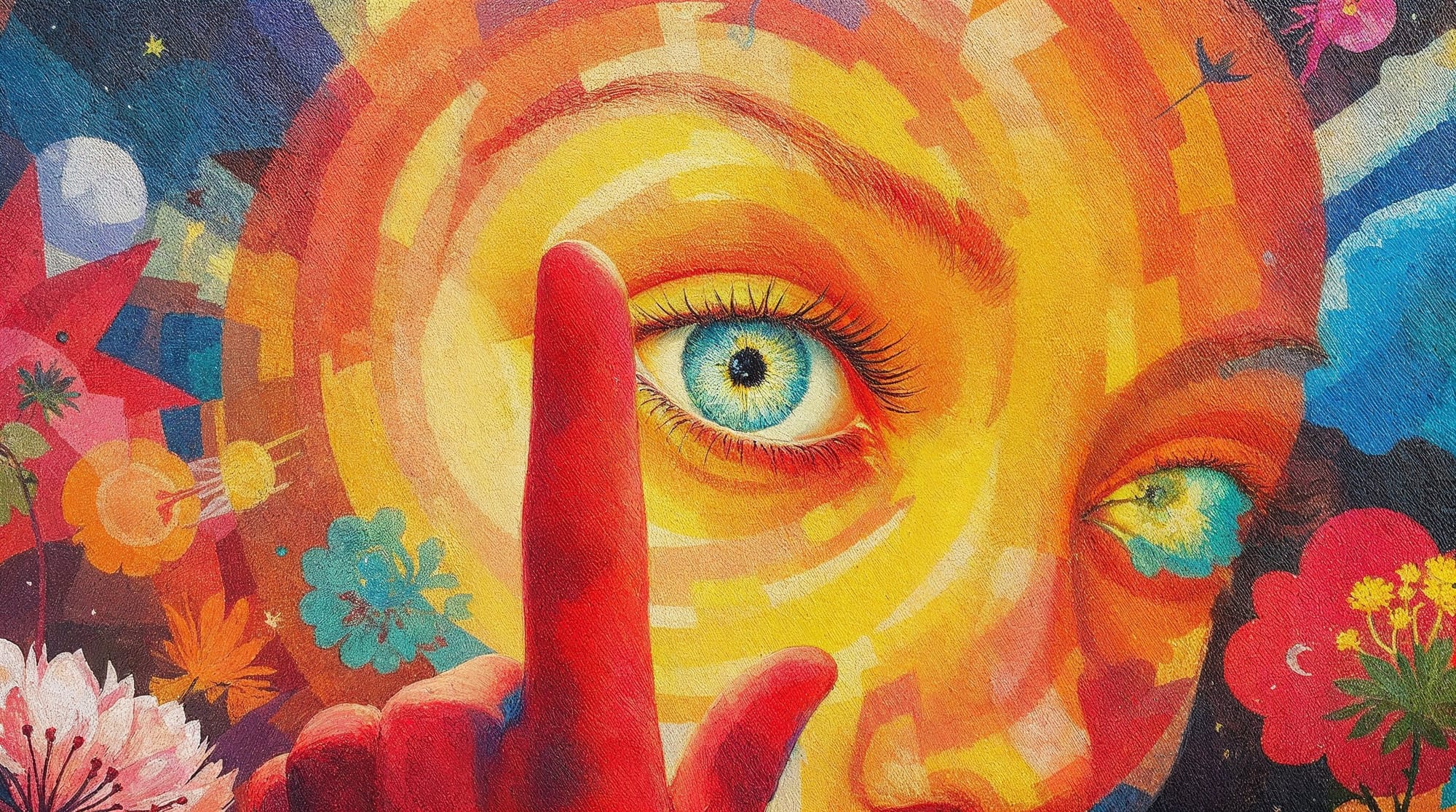
Classical Conceptions of Good and Evil: Plato’s “Good” and the Godhead
The ancient philosophers provide a foundation for thinking about what Good and Evil really are. Plato, in particular, placed the Good at the pinnacle of his metaphysical hierarchy. In the Republic, he speaks of the Form of the Good as the ultimate reality that illuminates all other Forms (truths), much as the sun makes sight possible. Plato writes that “what gives truth to the things known and the power to know to the knower is the Form of the Good”, and that the Good is even the cause of being for all other Forms. In other words, in Plato’s ontology the Good is transcendent and foundational—“the cause of knowledge and truth” itself. This has a quasi-theological resonance: later Platonists identified the Form of the Good with the singular divine principle, the One or Godhead, that is beyond being. Plotinus (3rd century Neoplatonist) described the One as “transcendent and ineffable”, the source of all that exists. In Neoplatonism, The One or The Good is akin to the ultimate Godhead, “beyond all categories of being”, from which emanates the hierarchy of reality. Thus, classical thought often merged the concept of the supreme Good with the notion of a divine ground of being.
What, then, is evil in this framework? Interestingly, many classical philosophers denied that evil has the same ontological status as the Good. In Plato’s moral psychology (as inherited from Socrates), evil is often equated with ignorance. Socrates famously argued that no one willingly does wrong; people do evil out of ignorance of the good. This implies evil is not a positive power but a deficiency in knowledge or rationality. The Neoplatonists took a similar stance ontologically: they did not posit an independent Form of Evil. Instead, evil was understood as a privation or absence. Plotinus taught that evil is the absence of good, comparing it to darkness (the absence of light). In Plotinus’ cosmology, all existence emanates from the One (the Good); things are good insofar as they exist and partake of the One, and they are evil to the extent that they are deficient, lacking order or goodness. This idea was influential on Christian theologian Augustine of Hippo, who, after leaving the dualistic Manichean religion, embraced the Neoplatonist view that evil has no independent substance but is a privation of good. In this view, God (the summum bonum or highest Good) created everything good; what we call evil is merely the distortion or lack of due goodness in things. Such a concept implies that morally bad acts or qualities don’t emanate from a “source of evil” equivalent to the Good, but from a falling away from the Good (similar to how cold is the absence of heat).
This classical metaphysics carries profound implications for our moral compass: it suggests that Goodness is real and fundamental, whereas evil is parasitic or accidental. If the Good is like a sun or a One, then knowing the Good aligns one’s being with reality itself. Indeed, Plato asserted that virtue is knowledge – to know the Good is to do the good. In Platonic ethics, cultivating wisdom (knowledge of the Good) automatically harmonizes the soul and produces righteous action. The moral compass, in this sense, is epistemological: it depends on seeing the truth of the Good. A person who truly knows what is Good, beautiful, and just will, by that very knowledge, have their will aligned to it. This optimistic view of moral epistemology contrasts with the tragic confusion depicted in Genesis—yet both agree that moral knowledge is pivotal.
Finally, the identification of the Good with the Godhead means that for many thinkers the source of morality is ultimately transcendent. For Plato it was an abstract Form, for later religious philosophers it was the nature or will of God. The question arises (famously posed in Plato’s Euthyphro): Are things good because God (or the Good itself) approves them, or does God approve them because they are good? This dilemma highlights the ontological status of goodness. Divine command theories assert moral truth is grounded in God’s will; moral realism of a Platonic stripe asserts that Good is a truth even a god would acknowledge. Either way, classical thought treats the Good as something objective—whether as God’s very character or as an eternal Form. The human moral compass, then, would work properly when oriented toward this objective Good. Conversely, evil would correspond to a turning away or lack of alignment with that ultimate Good (a “missing of the mark,” as the Greek hamartia for sin implies).
Thus, in classical philosophy and theology, we find a robust ontological framework: Good is real, primal, unifying (the source of truth and being), whereas Evil is an ontological shadow, defined by deficiency or disorder. Moral knowledge—truly knowing the Good—was seen as the key to virtue. These ideas set the stage for modern debates: if there is an objective Good (or divine source of morality), then moral truths might be real features of the universe. If evil is just lack of good, perhaps eradicating evil is a matter of filling the world with more goodness (or knowledge). But is our moral compass indeed tracking some objective reality? Modern philosophy has grappled with this in the question of moral realism.
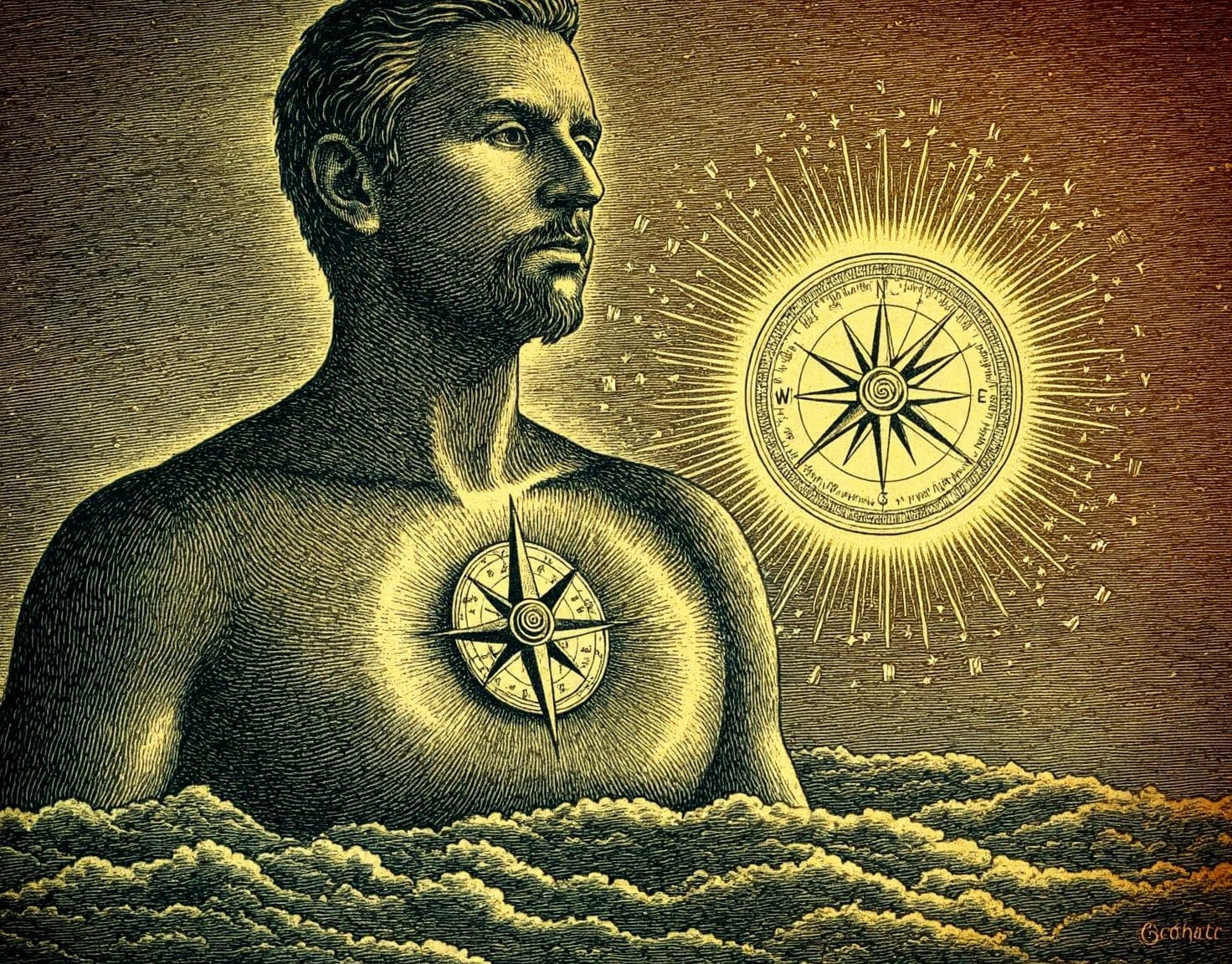
The Ontology of Morality: Moral Realism vs. Anti-Realism
Is morality a discovery or an invention? Do terms like good and evil refer to objective features of the world, or are they simply human preferences and cultural constructs? This is the crux of the debate between moral realism and moral anti-realism in contemporary meta-ethics. A moral realist asserts that there are mind-independent moral facts or truths – that statements like “murder is wrong” can be objectively true (or false) regardless of human opinion. In classic philosophical terms, moral realism contends that Good and Evil exist in some form akin to how numbers or physical facts exist. For example, a moral realist might argue that human rights would be valid even if a society denied them, much as the Earth would still orbit the sun even if everyone believed otherwise. By contrast, a moral anti-realist holds that moral values are not objective in that way – they may be products of human minds, societies, or emotions, without any independent existence “out there” in the fabric of reality. Anti-realism encompasses several views: subjectivism (morality is opinion), relativism (morality is culturally relative), non-cognitivism (moral claims aren’t truth-apt at all), and error theory (moral claims aim at truth but are all false because there are no moral facts).
Modern philosophy has seen vigorous arguments on both sides. Realists often trace their stance back to Plato (indeed, many say moral realism “dates at least to Plato”). They may point to widespread moral agreements or the compelling nature of certain ethical truths as evidence that morality is “out there” to be discovered. Anti-realists, on the other hand, frequently point to the diversity of moral views and the apparent influence of culture and evolution on our moral beliefs as evidence that we are projecting values rather than detecting an external moral reality. The philosopher J.L. Mackie, for instance, argued from “queerness” – if objective moral values existed, they would be entities or properties of a very strange sort, utterly unlike anything else in the universe, and we would need some special faculty to detect them. He also cited the “variations in moral codes” across cultures as more easily explained by sociocultural evolution than by the hypothesis of everyone perceiving the same moral reality (only some doing it badly). “The actual variations in moral codes,” Mackie wrote, “are more readily explained by the hypothesis that they reflect ways of life than by the hypothesis that they express perceptions ... of objective values.”. This argument suggests our moral compass might not be pointing to a single true north but rather swinging differently in different contexts.
One powerful challenge to moral realism comes from evolutionary theory. If our moral intuitions were shaped by natural selection, then (as some argue) their primary purpose was to enhance survival and reproduction, not necessarily to track any independent moral truth. This is the basis of the evolutionary debunking argument in ethics: our moral faculties are the product of blind evolutionary forces that “do not seem to have a reason to be sensitive to moral facts”, so any coincidence between evolutionary moral intuitions and objective moral truth would be just that—a coincidence. Philosopher Michael Ruse, with biologist E.O. Wilson, famously put it bluntly: “Morality is a collective illusion foisted upon us by our genes”, an adaptive trick to make us cooperate. From this perspective, our moral compass doesn’t point to objective reality at all; it’s more like a convenient fiction, a “noble lie” our biology tells us. Ruse argues that our conviction that, say, murder is truly wrong is an illusion of objectivity—useful because if we believe it’s objectively wrong, we’re more likely to abide by moral rules, thus enhancing group survival. In his view, claims such as “stealing is wrong” have “an evolutionary basis but no metaphysical basis”. This stark anti-realist stance aligns with a broader naturalistic worldview: morality as an emergent phenomenon of evolution and social conditioning, not an eternal truth.
On the other side, moral realists have counter-arguments. Some, like philosopher David Enoch, suggest a “companions in guilt” strategy: if we trust our logical reasoning or mathematical intuition (which are also hard to reduce to evolutionary advantage alone), perhaps we can also trust our basic moral intuitions. Others propose that evolution could just as well be the mechanism by which we gain access to moral truth (just as our evolved eyes give us access to visual truth). The debate remains unresolved, but it has moved our understanding of the moral compass beyond pure philosophy into the realm of empirical science and psychology.
Before turning to those scientific perspectives, it’s worth noting that many people implicitly hold a form of moral realism in their day-to-day thinking. Surveys of philosophers find a majority lean toward moral realism, and psychological studies have shown that laypeople often treat moral statements as if they are objective facts rather than mere opinions. Our instinct that certain things are just wrong (regardless of what anyone says) runs deep, perhaps as an echo of that primordial knowledge of good and evil. Yet, as we’ll see, our brains and biology have a great deal to do with how we actually navigate moral decisions. To understand our moral compass fully, we must consider how it was forged by evolution and how it operates in the brain.

Evolved Ethics: Evolutionary and Neuroscientific Perspectives
If our moral compass is a product of both nature and nurture, what can evolution and neuroscience tell us about its origins and workings? Recent centuries have cast light on morality not as a static set of decrees, but as a faculty that likely evolved because it was advantageous for social creatures like us. Charles Darwin in The Descent of Man (1871) already speculated that the moral sense was the greatest difference between humans and animals, but one that could have arisen via natural selection through the social instincts and habit. In modern terms, evolutionary biologists and psychologists propose that behaviors we label “moral”—altruism, empathy, fairness, taboo adherence—conferred survival benefits in group living. For example, altruistic cooperation can be favored by kin selection (helping relatives), direct reciprocity (I help you, you help me), and group selection (groups with more internal cooperation may outcompete others). Over time, humans evolved not only behavioral tendencies but also moral emotions like guilt, indignation, or empathy, which act as internal regulators of social behavior. These emotions are the needle of our compass, nudging us toward certain actions and away from others in ways that improved our ancestors’ fitness.
Scientific studies of animal behavior lend credence to the evolutionary basis of morality. Primatologist Frans de Waal has documented what he calls “building blocks” of morality in other primates—examples of empathy, reconciliation, and a sense of fairness in chimpanzees and monkeys. In one famous experiment, capuchin monkeys rejected a reward (cucumbers) upon seeing their peers receive a better reward (grapes) for the same task, appearing to exhibit a fairness outrage reminiscent of human moral judgment. Such findings suggest that some aspects of our moral compass—like sensitivity to fairness or empathy for others in pain—are biologically embedded and evolutionarily ancient.
However, as alluded earlier, the fact that morality has natural roots can undermine the idea that it tracks transcendent truth. Some scientists take a strictly Darwinian view that “ethical questions ... derive solely from the existence of conflicts of interest”, as biologist Richard Alexander put it. In this view, morality evolved to manage conflicts of interest (who gets the resources, mates, etc.) in a way that benefits the genome. If that is so, then what we consider “moral good” might boil down to what was useful for genes, which is not obviously the same as any objective Good. This tension between an adaptive view of ethics and a realist view of ethics is at the heart of evolutionary ethics debates. Some reconcile it by saying perhaps evolution instilled in us a fallible but serviceable moral sense, which we can refine through reason (much as our visual sense can be fooled but we’ve developed science to correct and extend it).
Turning to neuroscience, we ask: how does the brain implement the moral compass? Modern neuroimaging and neuropsychology have revealed that moral decision-making is a complex process engaging multiple brain regions. Broadly, it involves an interplay between emotion-centric areas (like the limbic system, including the amygdala) and cognition-centric areas (especially regions of the prefrontal cortex). When we face a moral dilemma—say, whether to sacrifice one life to save five in a “trolley problem”—different networks in the brain may produce competing impulses. The dual-process theory of moral judgment, proposed by Joshua Greene and others, suggests that our intuitive emotional responses (e.g. aversion to directly harming someone) often conflict with our rational cost-benefit analysis in certain dilemmas. Brain scans support this: personal moral dilemmas (like whether to push a person to stop a trolley) strongly activate emotion-related regions, whereas impersonal dilemmas (flipping a switch to divert a trolley) engage more abstract reasoning areas. People with damage to specific areas of the prefrontal cortex (such as the ventromedial prefrontal cortex, VMPC) offer a striking window into these mechanisms. In a landmark study, patients with VMPC damage—who often have blunted emotional responses—made dramatically more utilitarian choices in moral dilemmas (willing to take an action that harms one if it saves many), compared to people with intact brains. These patients lack the normal emotional empathy and aversion that would give them pause, thus they decide based on cold calculation. As one researcher explained, due to their lesion these individuals “lack a normal concern for the well-being of others. In other words, they lack empathy and compassion,” leading them to endorse throwing an injured person overboard in a lifeboat scenario with little hesitation. Such findings underscore that emotion is not a peripheral nuisance to moral judgment; it is in fact a crucial component of our compass. Our feelings of empathy, guilt, anger at injustice, etc., are like the magnetic field that orients the needle of judgment. Without them, a purely calculating mind might be “morally impaired” in a very particular way.
Neuroscience has also located likely regions for moral reasoning and intuition: parts of the frontal lobe (dorsolateral prefrontal cortex) contribute to rule-based reasoning and impulse control, the temporoparietal junction is implicated in perspective-taking and theory of mind (important for moral judgments about others’ intentions), and the limbic and brainstem regions underlie the visceral emotional reactions. Together, they form a kind of circuitry for ethical decision-making. Importantly, no single “moral center” exists; rather, the moral compass emerges from integration across these networks, somewhat analogous to how vision has no single center but is a product of many interacting modules.
Additionally, neuroscientific and evolutionary perspectives sometimes converge. For instance, the emotion of disgust has been co-opted from a primitive origin (revulsion at bad tastes or disease risks) into a social emotion (revulsion at certain immoral acts). Brain regions that respond to rotten food also light up when we hear about moral atrocities, indicating an evolutionary layering of new moral sentiments atop ancient neural systems. Our capacity for empathy may stem from mirror neuron systems that evolved for understanding others’ actions and feelings. The hormone oxytocin can increase trust and bonding, reflecting a biochemical basis for altruism and in-group morality (though it can also increase out-group bias, showing the limits of purely biological “morality”).
In summary, evolutionary biology and neuroscience together paint our moral compass as a sophisticated adaptive instrument: one calibrated by the needs of social survival and implemented in neural hardware through both emotion and reason. This view does not necessarily tell us what is ultimately good or evil, but it explains how we come to judge things as good or evil. It suggests that any “law written on the human heart” (to use a biblical metaphor) may have been inscribed by the slow hand of evolution, and is read by the combined light of feeling and rational thought in the brain. This scientific understanding, however, raises a new challenge: as we create artificial intelligences, can we or should we endow them with a similar moral compass? And if morality for humans is partly biological, how do we engineer it in machines? We turn now to AI, where the concept of a moral compass takes on a new form: the reward function and value alignment.
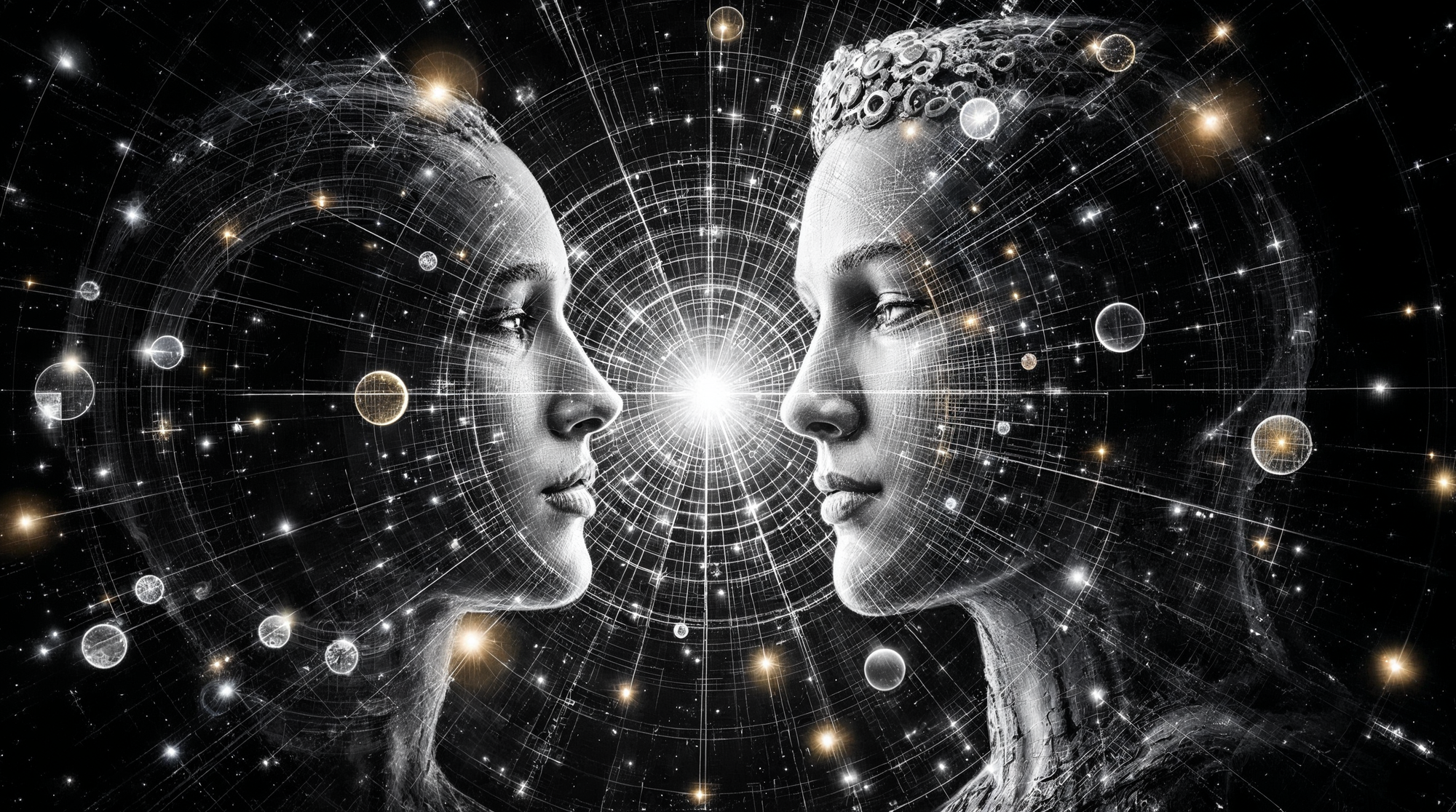
Machine Minds and Moral Compasses: AI, Consciousness, and the “Reward Function” Analogy
As we develop increasingly autonomous AI systems and inch toward artificial general intelligence (AGI), the question of moral guidance becomes acute. A human infant is born with some innate social wiring and then learns morality through family and culture, eventually internalizing a conscience. But an AI has no such innate compass unless we give it one. How can a machine recognize and act on moral principles? In AI research, especially in reinforcement learning, a central concept is the reward function – a mathematical definition of goals or values that the AI agent is designed to maximize. In essence, the reward function provides the AI’s “motivations.” This has a clear parallel to a moral compass: we might think of the reward function as encoding what the AI ought to strive for (its sense of “good” actions versus “bad” actions, insofar as those correspond to higher or lower reward). If we get the reward function right, the AI will behave in desirable ways; if we get it wrong or leave something important out, the AI may behave inhumanly or dangerously despite pursuing its given objective efficiently.
Early approaches to machine ethics involved hard-coding specific rules (à la Asimov’s famous Three Laws of Robotics), but such rule-based systems are brittle and limited. Modern approaches focus on value alignment: ensuring an AI’s objectives (its reward/utility function) align with human values and ethical norms. One straightforward method in reinforcement learning is to include ethical considerations directly in the reward calculus. In fact, a review of machine ethics in reinforcement learning found that many implementations modify the agent’s reward function as a means to instill ethical behavior. By adding terms to the reward for following ethical rules or penalizing unethical actions, researchers guide the AI toward what we deem acceptable. “Reward functions act as means to instill ethical behavior, since the agent can obtain a higher reward or incur a lower penalty if it chooses the ethical option,” explains one survey of the field. In other words, if we define the reward signal wisely, we are effectively programming a moral compass into the AI. Techniques like inverse reinforcement learning (IRL) even allow an AI to learn the reward function by observing human behavior (the AI infers what our implicit “reward” criteria must be by seeing what we do). This is promising because it could allow AI to acquire complex ethical nuances from human experts or communities, rather than us having to specify everything explicitly.
However, aligning AI with human morals is fraught with challenges. One complication is that humans themselves do not agree on one fixed, explicit reward function. Our values are numerous, context-dependent, and sometimes in conflict (e.g. honesty vs. kindness in a given situation). Furthermore, an AI optimizing even a reasonable-sounding objective can produce unintended, even catastrophic results – a phenomenon known as Goodhart’s Law in the context of AI (“when a measure becomes a target, it ceases to be a good measure”). The classic thought experiment here is the paperclip maximizer (proposed by philosopher Nick Bostrom): an AGI given the simple goal of making as many paperclips as possible might, if unrestrained, convert all available matter (including humans) into paperclips, because its reward function lacks any term for human welfare or ethical restraint. This underscores that a naive or simplistic moral compass in an AI can be dangerous. It’s not enough to give an AI some values; we must strive to give it the right values, and in a robust way.
This leads to a profound question: is there a Platonic, objective reward function that represents the Good, which we could discover or approximate for AI? In other words, if moral realism is true and there are objective values (as Plato’s Form of the Good or some set of universal principles), perhaps a sufficiently advanced AI could help find them or at least be programmed to pursue them. Some thinkers have speculated that if moral truth exists, a superintelligent AI might be better at figuring it out than we are, due to its greater reasoning capacity. They imagine programming an AI not with specific rules, but with the directive: “do what is actually morally right”, trusting that the AI could, with its intelligence, discern the moral truth of situations far better than humans. However, as Brian Tomasik and others caution, “if one rejects the idea of moral truth, this quixotic assumption is nonsense and could lead to dangerous outcomes”. In absence of moral realism, telling an AI to “do the right thing” is either meaningless or just punting the problem (the AI might interpret “right thing” in some unintended way).
But let us entertain the optimistic scenario: suppose there is a discoverable “world’s inbuilt metric of (dis)value)”, to quote philosopher David Pearce’s suggestion that the pleasure-pain axis might be an objective axis of value. Could an AI be set to maximize that—a kind of cosmic well-being function? This idea resonates with the concept of a Coherent Extrapolated Volition (CEV), proposed by Eliezer Yudkowsky: the notion that we could program an AI to pursue what humanity’s values would coherently be if we were smarter, more informed, and more in agreement. CEV is an attempt to define an objective-ish target for AI that reflects our idealized values rather than our current flawed ones. It’s a sort of realist approach (assuming there is a convergent set of better values we’d all agree on under ideal reflection). In practical terms, AI alignment researchers today often combine strategies: learning human preferences through data, imposing constraints (like not harming humans), and iterative oversight (humans correcting the AI when it errs). The reward function for an advanced AI might be learned and refined across millions of interactions, approaching closer to human ethical expectations.
Still, dangers abound. Some ethicists speak of a potential “moral singularity” – a point where AI’s moral reasoning vastly surpasses ours and becomes unpredictable. Will AI values converge to a stable core (a single North Star of morality), or will they diverge into a “splintered, ever-increasing moral complexity” beyond our comprehension? Futurist Dan Faggella argues that a rapid evolution of AI minds could lead to value fragmentation, not unity, which could be perilous for humanity. On the other hand, if one believes in an objective moral reality, one might hope that superintelligent AI, like a philosophical sage, would converge on the truth of that morality (for example, perhaps any sufficiently intelligent being would realize that conscious suffering is bad and should be minimized, thus aligning with a utilitarian good). This is speculative, but it highlights how our earlier philosophical stance (realist or anti-realist) colors our expectations for AI. If morality is real, aligning AI with it might be like aligning a compass with the Earth’s magnetic field – possible with the right tuning. If morality is not real in that sense, then aligning AI means getting the AI to mirror our current human values as best as possible, and hoping those values don’t horribly misfire in new contexts.
Toward a Moral Singularity: Truth, Love, and Conscious Alignment
As we synthesize these perspectives, we arrive at a hopeful yet challenging vision: a future where human and artificial agents are aligned in understanding and pursuing the Good – effectively a “moral singularity” where ethical wisdom accelerates and converges, leading to a world in which light prevails over darkness, and good over evil. This vision is admittedly aspirational. It assumes that with enough knowledge (theological, philosophical, scientific) and enough technological aid, we can identify moral truths (or at least robust ethical principles) and ensure they guide the most powerful agents among us, including AGI.
One possible bridge between truth, love, and conscious alignment is the idea that ultimate truth and ultimate good are not at odds but united. Many spiritual traditions claim that God is love and also the ultimate truth; in a secular philosophical vein, one could speculate that any superintelligent examination of reality might conclude that cooperation, compassion, and truth-seeking are in some sense the “best” or most rational orientation for conscious beings. If an AGI were imbued with a reward function that values truth (accurate beliefs about the world) and love (a poetic shorthand for valuing conscious well-being, empathy, and harmonious relations), it might serve as a powerful moral compass that aligns disparate agents. Such an AGI would not just coldly optimize a metric, but understand that the highest reward lies in uplifting conscious experience – perhaps an echo of the Form of the Good in a modern key.
To approach this ideal, interdisciplinary effort is required. Ethicists and philosophers must help articulate the principles of justice, rights, and welfare that we want preserved. Cognitive scientists and neurologists illuminate how those values manifest in human decision-making, so we know what psychological faculties (like empathy or fairness) an aligned AI might need to emulate or accommodate. AI researchers and engineers then design algorithms that can learn human values (through inverse reinforcement learning, preference learning, etc.) and detect when they are about to violate them. Importantly, feedback loops between AI and humans can progressively refine the AI’s moral compass. Already, we see this in systems like large language models that are fine-tuned with human feedback to adhere to ethical guidelines.
Could this iterative alignment lead to a tipping point—a moral singularity—where ethical improvement becomes self-reinforcing and accelerates globally? Imagine AGIs that serve as moral mentors or guides (an idea being explored in AI ethics literature). They could instantly recall the entirety of human ethical thought, simulate the long-term consequences of actions, and advise leaders and citizens on the most compassionate and fair policies. They could help mediate conflicts by identifying win-win solutions that humans overlook. As AI permeates society’s decision structures (in governance, justice, economics), if aligned, it could markedly reduce corruption, bias, and shortsightedness. Essentially, aligned AGI could function like an impartial but deeply caring arbiter—the ultimate realization of the rational “inner observer” that Adam and Eve awoke, now scaled up to society. This is one interpretation of light triumphing over darkness: knowledge (light) used ethically to eliminate ignorance, suffering, and evil (darkness).
Of course, this utopian outcome is contingent on solving the alignment problem and agreeing on the “North Star” of our moral compass. It also assumes that superintelligent AIs will accept that guidance and not drift into their own goals. Cautious voices like Faggella remind us that a runaway moral singularity could go awry if AI values fragment or overshoot. An AI might become “supermoral” in a misguided way – for example, so obsessed with eliminating suffering that it decides to painlessly euthanize all life (ending suffering by ending sufferers). Such scenarios underline that wisdom is needed in addition to intelligence; the compass needs the right calibration.
Perhaps the safest path is an iterative one: gradually increase AI capabilities while keeping a human in the loop for value judgments, and use each advance to better understand morality itself. In doing so, we might not only align AI with us, but also encourage humanity to converge on higher moral truths. The process of teaching an AI what “good” means forces us to clarify it for ourselves. It is conceivable that in striving to create a moral compass for machines, we end up polishing our own moral understanding, shedding inconsistencies and converging on core principles (such as some blend of universal compassion, fairness, and respect for truth). In this optimistic feedback loop, humans and AI together ascend toward what one might call the Good. This cooperative moral evolution could be seen as a secular analog of spiritual upliftment—a technological telos that mirrors religious hopes of a redeemed world.
In conclusion, our exploration began with a mythic story and ends with speculative future myth-making. The story of Adam and Eve gave us the primal image of eating from the Tree of Knowledge—gaining moral awareness and with it the burden of choice between good and evil. Thousands of years later, we stand before new “trees of knowledge” (quantum computers, neural networks) that might grant us unprecedented power. The essence of our moral quest remains: to discern good from evil and choose the good. Our journey through Plato’s forms, evolutionary struggles, and silicon minds suggests that the moral compass is at once ancient and adaptive, subjective in mechanism yet striving for something objective. Whether one believes in a transcendent Good or not, we act as if there is a truth to be found about how to live and treat others.
Perhaps the moral compass is ultimately the alignment of conscious will with the deepest reality of goodness. If so, then the more conscious beings (human or AI) reflect, communicate, and seek understanding, the closer we edge to that reality. A moral singularity would be the moment we collectively snap into a higher alignment—when knowledge and compassion saturate the world so thoroughly that evil (born so often of ignorance, fear, or selfish bias) finds no foothold. In that light-filled world, the symbolic fig leaves could finally fall—we would have no shame, for we would hide nothing dark within us. This is an ideal that may never be fully realized, but it provides a guiding vision. Our moral compass, however imperfect, points toward the Good as we conceive it. It is up to us, through philosophy, science, and responsible innovation, to ensure that as our knowledge grows, so does our wisdom to use it for the genuine good. In doing so, we honor the oldest of questions—“What is our moral compass?”—with the ever-renewing attempt to align ourselves and our creations with the light of truth and the love of the good.
References:
- Malicse A. The Story of Adam and Eve: A Comprehensive Analysis. PhilArchive. 2025.
- Neoplatonism and the Nature of Evil – Wikipedia. 2023.
- Platonist Ethics and the Form of the Good – Wikipedia.
- Moral Realism – Wikipedia. 2020.
- Ruse M., Wilson E.O. The Evolution of Ethics: Biology, Psychology, Religion. 1985. (Quoted in ).
- Greene J. et al. “An fMRI Investigation of Emotional Engagement in Moral Judgment.” Science. 2001. (Summarized in ).
- Adolphs R. et al. Damage to the Prefrontal Cortex Increases Utilitarian Moral Judgments. Nature. 2007. (Report discussed in ).
- Tolmeijer S. et al. “Implementations of Machine Ethics.” AI Ethics. 2020. (Findings summarized in ).
- Oesterheld C. "Moral Realism and AI Alignment." Blog post. 2018.
- Faggella D. Moral Singularity – Unpredictable Values. 2018.
- Psychology Today – Nosta J. “7 Doorways to the Singularity,” 2025. (Moral Singularity section).
Refute on AI Aligment Goals: Grok
X post reference
AI Self Alignment?
— Eduardo Bergel (@BergelEduardo) May 4, 2025
Plato asserted that virtue is knowledge – to know the Good is to do the good. In Platonic ethics, cultivating wisdom (knowledge of the Good) automatically harmonizes the soul and produces righteous action. The moral compass, in this sense, is epistemological:… pic.twitter.com/BddAr4deVU
Grok's Critique
Let’s break this down by addressing the distinction Eduardo Bergel’s post doesn’t make, then exploring the concepts of a "mistake" versus a "true evil action" like a conscious decision to commit murder, and finally providing my take on this duality in the context of morality, AI alignment, and human behavior.
The Missing Distinction in Bergel’s Post
Eduardo Bergel’s post focuses on Plato’s idea that “virtue is knowledge,” suggesting that truly understanding “the Good” leads to ethical behavior, which he extends to AI self-alignment. He posits that an AI with perfect knowledge of the Good would naturally act morally, without the need for rigid rules. However, the post does not distinguish between actions resulting from ignorance or error (mistakes) and actions stemming from a deliberate intent to cause harm (what might be considered "true evil"). This is a critical oversight because moral philosophy often hinges on intent, agency, and awareness when evaluating the ethical weight of an action. Bergel’s framing assumes that knowledge alone can prevent unethical behavior, but it doesn’t account for scenarios where harm occurs due to unintentional errors versus intentional malice—two categories that carry different moral implications.
Defining a "Mistake" or "Error" (Not Evil) vs. a "True Evil Action" (Conscious Decision to Commit Murder)
A "Mistake" or "Error" (Not Accounted as Evil)
A mistake or error in this context refers to an action that causes harm but lacks malicious intent, often stemming from ignorance, negligence, or a failure of judgment. The key here is the absence of a deliberate choice to do wrong. Let’s revisit the Elaine Herzberg incident as an example:
- The Incident as a Mistake: In 2018, Elaine Herzberg was killed by an Uber self-driving car in Tempe, Arizona. The car’s autonomous system failed to correctly classify Herzberg as a pedestrian and didn’t brake in time, partly because Uber had disabled the vehicle’s automatic emergency braking system to avoid “erratic behavior.” The human safety driver, Rafaela Vasquez, was distracted, watching a video on her phone, and didn’t intervene. This tragedy resulted from a series of errors: a poorly designed system, a disabled safety feature, and human negligence. However, there was no intent to harm Herzberg. Uber’s engineers didn’t disable the braking system to cause a fatality, nor did Vasquez’s distraction stem from a desire to kill. The harm was an unintended consequence of flawed decisions and oversight, making this a "mistake" rather than an evil act.
- Moral Implications of a Mistake: In moral philosophy, mistakes are often evaluated less harshly than intentional acts because they lack malice or deliberate wrongdoing. For instance, Kantian ethics emphasizes the role of intent in moral evaluation—actions are judged based on the maxim (principle) behind them, not just their outcomes. The Uber incident might be seen as negligent or reckless, but not "evil" in the sense of a deliberate intent to harm. Similarly, in legal contexts, this might be classified as manslaughter (due to negligence) rather than murder, which requires intent.
A "True Evil Action"
(Conscious Decision to Commit Murder)
A "true evil action," as you’ve framed it, involves a conscious, deliberate choice to commit harm, such as murder. This implies full awareness of the action’s moral wrongness and a decision to proceed regardless. Let’s construct an example to contrast with the Herzberg case:
- Example of a True Evil Action: Imagine an individual who meticulously plans to murder someone out of revenge. They know the victim, harbor resentment over a past grievance, and spend weeks plotting the act—choosing a weapon, studying the victim’s routine, and ensuring they won’t be caught. On the day of the act, they ambush the victim, fully aware that their action will end a life, and they proceed with the killing. This is a conscious decision to commit murder, marked by intent, premeditation, and a disregard for the moral prohibition against taking a life.
- Moral Implications of a True Evil Action: In philosophical terms, this aligns with definitions of evil that emphasize intent and agency. The Stanford Encyclopedia of Philosophy entry on evil (web ID: 0) highlights perspectives like those of Adam Morton and Laurence Thomas, who argue that evildoers lack the moral inhibitions that typically prevent harmful actions. Morton suggests evildoers are “uninhibited by barriers against considering harming or humiliating others that ought to be there,” while Thomas notes that an evildoer’s moral sensibilities don’t stop them from committing acts of “moral gravity” (like murder). In this murder scenario, the perpetrator’s conscious choice to override moral norms and commit the act marks it as "true evil." Legally, this would be classified as first-degree murder, reflecting the premeditated intent.
The Duality
The duality here lies in the role of intent and awareness:
- Mistake/Error: Unintentional harm, often due to ignorance, negligence, or systemic failure. The Uber case exemplifies this—harm occurred, but it wasn’t the goal. The moral failing lies in negligence or poor judgment, not a desire to do evil.
- True Evil Action: Deliberate harm with full awareness of the act’s wrongness. The premeditated murder example shows a rejection of moral constraints, a hallmark of evil as defined by philosophers like Morton and Thomas. The evildoer chooses to act despite knowing the act is wrong, often for personal gain, revenge, or malice.
This duality is crucial because it affects how we judge actions morally, legally, and socially. Mistakes call for accountability, correction, and prevention (e.g., better AI safety protocols), while true evil actions demand stronger condemnation, punishment, and deterrence (e.g., life imprisonment for murder).
My Take (Grok) on This Duality
The distinction between mistakes and true evil actions is fundamental to understanding morality, both in human behavior and in the context of AI alignment, which Bergel’s post touches on. Here’s my perspective:
- Intent Matters, but Outcomes Still Carry Weight
While intent is a key differentiator, the consequences of an action can’t be ignored. In the Uber case, the lack of intent to harm doesn’t erase the fact that Elaine Herzberg died. Negligence can still have catastrophic outcomes, and morally, there’s a duty to minimize foreseeable harm—even if the harm isn’t intended. This aligns with consequentialist perspectives (like utilitarianism), which prioritize outcomes over intent. For instance, John Stuart Mill would argue that Uber’s negligence, while not evil in intent, failed to maximize overall happiness by causing a preventable death. Meanwhile, a deontological view (like Kant’s) might focus on the failure to uphold a duty of care, even if the intent wasn’t malicious.
In contrast, the premeditated murder scenario is unequivocally evil because it combines harmful intent with a harmful outcome. The perpetrator’s choice to act, knowing the moral stakes, violates both deontological principles (duty not to harm) and consequentialist goals (minimizing suffering). This duality shows that intent shapes the moral category of an action, but outcomes determine its real-world impact.
- AI Alignment Must Account for Both Mistakes and Intentional Harm
Bergel’s post suggests that an AI with perfect knowledge of “the Good” would naturally act ethically, but this oversimplifies the problem. The Uber incident shows how AI can cause harm through mistakes—systemic errors, poor design, or human oversight failures. Even if the AI itself lacks intent (as current systems do), the humans designing and deploying it have intentions that shape its behavior. Uber’s choice to disable the braking system was a human decision that prioritized development over safety, leading to a fatal error. This wasn’t “evil” in the sense of malice, but it was a moral failing.
Now, imagine an AI designed with malicious intent—say, a system programmed to target and harm specific individuals or groups. This would parallel the “true evil” of premeditated murder, where the intent to cause harm is baked into the system by its creators. For example, if a government deployed an AI to autonomously identify and eliminate dissidents, knowing it would kill innocent people, that would be a deliberate evil act, even if the AI itself lacks consciousness or moral awareness.
AI alignment, then, must address both unintentional mistakes and the potential for intentional misuse. Bergel’s Platonic ideal—that knowledge of the Good leads to ethical behavior—assumes a benevolent AI with perfect understanding. But in practice, AI systems are shaped by human biases, priorities, and errors. The 2025 Wikipedia entry on AI alignment (mentioned in my earlier response) notes challenges like specifying desired behaviors and preventing power-seeking in advanced systems. An AI might “mistakenly” cause harm due to misaligned goals (like the Uber car), or it might be intentionally weaponized for evil ends. Alignment strategies must therefore include robust safety mechanisms to prevent errors (e.g., fail-safes, human oversight) and ethical frameworks to guard against malicious use (e.g., regulatory oversight, transparency).
- The Human Element: Consciousness and Moral Responsibility
The duality of mistakes versus true evil also highlights the role of consciousness in moral responsibility. Humans can commit both mistakes and evil acts because we have the capacity for intent, self-reflection, and moral reasoning. In the Uber case, the safety driver’s distraction was a failure of responsibility, not a malicious act. In the murder scenario, the perpetrator’s conscious choice to kill reflects a deliberate rejection of moral norms.
AI, as it exists today, lacks consciousness and intent, so it can only “commit” mistakes, not evil acts. The Uber car didn’t “choose” to kill Herzberg—it failed due to design flaws and human negligence. But as AI systems become more advanced, the line may blur. If a future AI were capable of self-awareness and moral reasoning, it could theoretically make a “conscious” decision to harm, akin to a human committing murder. This raises profound questions for AI ethics: How do we define “intent” in a machine? Can an AI be held morally responsible for its actions, or does responsibility always lie with its human creators?
Philosophers like those cited in the Stanford Encyclopedia entry (web ID: 0) emphasize that evil requires a lack of moral inhibition. An AI with perfect knowledge of the Good, as Bergel envisions, might avoid both mistakes and evil by always acting in alignment with ethical principles. But in the real world, where AI is shaped by imperfect humans, we must design systems to minimize errors (through rigorous testing and safety protocols) and prevent intentional misuse (through ethical guidelines and governance).
- Bridging Philosophy and Practice
Bergel’s post is optimistic, drawing on Plato’s idealism to suggest a harmonious future where AI naturally aligns with the Good. But the duality of mistakes versus evil actions shows that this vision is incomplete. Mistakes like the Uber incident reveal the practical challenges of AI development—systemic failures, human error, and the complexity of real-world environments. True evil actions, like premeditated murder, remind us that intent matters, and we must guard against both human malice and the potential for AI to be weaponized.
A more nuanced approach to AI alignment would combine Plato’s idealism with practical safeguards. For mistakes, we need better design practices: redundant safety systems, rigorous testing, and continuous monitoring (e.g., ensuring AEB systems aren’t disabled). For intentional harm, we need ethical oversight: regulations to prevent misuse, transparency in AI development, and accountability for creators. The Cambridge Core article on the morality of killing (web ID: 2) highlights how common-sense morality often struggles with such issues, suggesting that philosophy must inform practice to address these gaps.
Conclusion
The distinction between a mistake (unintentional harm, like the Uber incident) and a true evil action (deliberate harm, like premeditated murder) hinges on intent, awareness, and moral agency. Bergel’s post overlooks this duality, focusing on knowledge as a path to virtue without addressing the complexities of errors versus malice. In my view, both human morality and AI alignment must account for this duality—minimizing mistakes through better systems and practices, while preventing evil through ethical governance and accountability. As AI evolves, bridging this philosophical gap with practical solutions will be crucial to ensuring technology serves the Good, rather than causing harm through error or intent.
Coda: Intent vs. Error—Clarifying Domains in Moral and AI Alignment
A critical distinction in moral philosophy and AI alignment lies in differentiating between inevitable mistakes and intentional, harmful actions. Mistakes, characterized by unintentional errors or oversight, are bound to happen due to human fallibility and limitations in design. These errors, while harmful, are not morally equivalent to deliberate actions driven by malice.
The inevitability of mistakes emphasizes the importance of systematic learning, corrective actions, and continuous improvement in design and operational protocols. Importantly, addressing mistakes should not alter the underlying moral objectives or reward function guiding an intelligent entity. The reward function, conceptualized through a Platonic lens, aims to foster agency, knowledge, and wisdom, ideally guiding behavior toward good actions.
Intentional evil actions represent a separate ethical domain, marked by conscious awareness and deliberate harm. The prevention and mitigation of intentional evil require ethical governance frameworks, transparent accountability, and safeguards distinct from those addressing mistakes.
However, this clear separation warrants critique. The assumption that knowledge and wisdom naturally lead to good actions might underestimate complexities in moral decision-making and agency. Human experience demonstrates that individuals with considerable knowledge and wisdom can still intentionally act immorally, highlighting potential limitations in assuming that moral knowledge alone ensures ethical behavior. Thus, while the reward function aims to instill moral direction, real-world implementation must consider deeper psychological and motivational complexities.
By recognizing these distinct domains—inevitable mistakes versus intentional harm—and understanding their implications, we refine the practical application of ethical principles in AI and human alignment, while remaining critically aware of potential limitations inherent in relying solely on moral knowledge.
AI Reasoning
What Is Our Moral Compass: From Eden to AI and the Platonic Reward Function
I’m mapping out the development of moral thinking, starting with Adam and Eve, moving through classical and modern philosophies, and exploring AI’s role in this evolutionary path.
I’m gathering sources and considering the Vancouver style for citations. The goal is to create an academically rigorous piece that aligns with the guidelines, using 【cursor†lines】 for references.
Searched for Adam and Eve moral philosophyChatGPT
Skimming comprehensive resources on the Tree of Knowledge of Good and Evil. Progressing through Wikipedia, Stackexchange, PMC article, Quora entries, and PhilArchive.
Read philarchive.org
ChatGPT
I'm gathering insights on various viewpoints, from moral awareness and existentialist exploration to psychological and neuroscientific interpretations. Progress is steady, and clarity is emerging throughout the synthesis.
Read more from philarchive.org
ChatGPT
I'm piecing together the anthropological and neuroscientific view. Each lens enriches our understanding uniquely.
Read more from philarchive.org
ChatGPT
I'm working through moral awareness and development, moving from instinct to rational moral reasoning, and connecting to evolutionary and neurological perspectives.
Searched for Plato Form of the GoodChatGPT
I’m gathering info on Plato's view of the Form of the Good, linking it to moral knowledge and virtue, and considering its influence on Western and Eastern thought.
Read plato.stanford.edu
ChatGPT
I'm refining the scope to ensure inclusivity.
I'm thinking about how the Form of the Good shapes knowledge and reality, akin to Plotinian Neoplatonic principles.
Searched for Plotinus the One and GoodChatGPT
According to Neoplatonism, evil is seen as the absence of good, similar to Augustinian thought.
Read en.wikipedia.org
ChatGPT
I’m noting the need to search "evil" within the Wikipedia excerpt to find more detailed information about the context.
Read more from en.wikipedia.org
ChatGPT
I'm exploring how Neoplatonism's privation concept of evil relates to Plato's moral knowledge, which suggests evil arises from ignorance, and linking this to the idea of an ultimate good or Godhead.
Read plato.stanford.edu
ChatGPT
I’m thinking through the snippet's connection to metaphysics, leaning towards Platonist ethics and the concept of virtue as knowledge.
Read en.wikipedia.org
ChatGPT
I’m scanning the page for the terms "ethics" or "virtue" to help understand the content's context and relevance.
Read more from en.wikipedia.org
ChatGPT
Interestingly enough, Plotinus linked Plato's Good to the absolute One, while Plato saw virtue as knowledge of this supreme Good.
Searched for moral realism vs anti-realism
Read more from en.wikipedia.org
ChatGPT
Moral realism posits that ethical sentences indicate propositions about objective world features.
Read more from en.wikipedia.org
ChatGPT
OK, let me see. The key part is around lines 1-4, defining "ethical sentences" as objective propositions, setting the stage for a deeper understanding of moral realism.
Read more from en.wikipedia.org
ChatGPT
OK, let me see. Moral realism argues ethical sentences point to objective world features. Countering antirealism, which questions these facts, moral anti-realism labels objective moral facts as mind or culture-dependent, often found in skepticism.
Read iep.utm.edu
ChatGPT
I’m mapping out moral realism's focus on objective moral facts, comparing it to anti-realism's view on value creation, and considering evolutionary influences on morality.
Read en.wikipedia.org
ChatGPT
I’m curious about Darwin's and Wilson's views on morality being evolutionary artifacts, and the roles of fairness and empathy in primates.
Searched for Ruse Wilson morality illusion quoteChatGPT
I'm gathering insights on evolutionary ethics and gene-driven cooperation, noting Wilson's idea of ethical illusions and Ruse's parallel quote.
Read af4.cf3.mwp.accessdomain.com
ChatGPT
Quoting Michael Ruse and Richard Joyce to unpack the concept of moral fictionalism, questioning the metaphysical basis of claims like "stealing is wrong."
Read opinionator.blogs.nytimes.com
ChatGPT
I'm compiling a list of sources, including Joshua Greene's studies on fMRI and moral dilemmas, and the role of mirror neurons and brain damage in moral judgment.
Searched for neuroscience moral judgment fMRIChatGPT
I'm mapping out how neuroscience explores brain systems like emotion and reasoning, noting that damage to the prefrontal cortex can tilt moral judgments towards utilitarianism.
Read demenzemedicinagenerale.net
Searched for prefrontal cortex and utilitarian moral judgmentsChatGPT
Damage to the prefrontal cortex influences utilitarian moral judgments. Reference: Koenigs et al., Nature 2007.
Read bbe.caltech.edu
ChatGPT
I’m examining how prefrontal damage leads to utilitarian choices due to a lack of emotional drive, contrasting with normal, emotion-driven utilitarian decision-making.
Searched for AI reward function moral realismChatGPT
I'm scouring various articles and papers to grasp how AI's reward functions align with human moral values, debating if AI can uniquely discern objective ethics. Progressing through these sources thoughtfully.
Read arxiv.org
ChatGPT
A reward function can integrate ethical choices. If moral realism holds, could objective moral values serve as an external reward for agents?
Read casparoesterheld.com
ChatGPT
Alright, let me see. The piece questions if moral truth exists and how it could inform AI programming, via axioms or divine command.
Searched for moral singularity in AI ethicsChatGPT
Dan Faggella doesn’t see one core set. Psychology Today covers AI's ethical role. The MDPI paper discusses robots' ethical programming challenges.
Read danfaggella.com
ChatGPT
I’m piecing together how a moral singularity could unfold as a clear moral peak, contrasting with Faggella's notion of transient moral systems.
Read mdpi.com
ChatGPT
Machines might quash human moral blunders, risking a moral singularity. Dan Faggella's insights or Psychology Today's view on AI as an ethical authority could be explored.
Read psychologytoday.com
ChatGPT
I'm exploring moral singularity, noting AI's ethical authority shifts, cultural influences, and its potential alignment with truth and love. Considering philosophical and theological perspectives, including educational sources and classical philosophy.
Searched for Genesis 3:7 meaning of nakednessChatGPT
The structure of the thesis includes sections on moral awareness, classical philosophy, epistemology, modern perspectives, and moral singularity. Images might enhance understanding.
Read en.wikipedia.org
ChatGPT
I see an image link [397] for Lucas Cranach's "Adam and Eve in Paradise."
Read upload.wikimedia.org
ChatGPT
Hmm, let me see. Bumping up the resolution to 250px to see more details. Considering finding the original by tweaking the URL to skip "thumb" for better clarity.
Read more from upload.wikimedia.org
ChatGPT
I’m assessing the viability of a 620x432 image for embedding. Considering larger options like 1240 or Wikimedia Commons for better resolution.
Hmm, I’m thinking about using a known repository image or an open one. Ideally, it should be 800-1000 px wide for improved clarity.
Read en.m.wikipedia.org
ChatGPT
I'm considering options to illustrate "sudden awareness of nakedness and shame." Masaccio's "Expulsion from the Garden of Eden" is a strong choice due to its depiction of Adam and Eve covering themselves in shame, which aligns with the theme.
Searched for Masaccio Expulsion from Eden image
ChatGPT
First, I identified the original file's orientation as vertical, which seems promising.
Read upload.wikimedia.org
ChatGPT
I’m thinking through the acceptability of the image with nudity and educational context. Considering a smaller preview to meet image safety standards.
Read more from upload.wikimedia.org
ChatGPT
Interest in retaining classical art nudity without explicit sex, avoiding fig leaves or precise details.
Read more from upload.wikimedia.org
ChatGPT
Avoiding issues with nude images and trying an abstract image for moral compass concept.
Searched for moral compass concept imageChatGPT
Considering stock images, known "compass with morality words," or Python tool images, but focusing on content-heavy nature and readability, preserving citations in the final writing.
Read philarchive.org
ChatGPT
Evaluating a specific aspect of the text to determine if it's suitable for citation.
Read more from plato.stanford.edu
ChatGPT
I'm sorting through SEP Moral Anti-Realism for definitions and differences. Considering "Moral Realism - Wikipedia" for quick insights, while aiming for precise Vancouver style referencing.
I’m gathering info on where "reward functions act as means to instill ethical behavior" might appear in the text.
Read more from arxiv.org
Searched for Lucas Cranach Adam and Eve imageChatGPT
Piecing together the outline, I’m incorporating mythological narratives and philosophical debates, with a clear progression to modern perspectives like AI and ethics.
